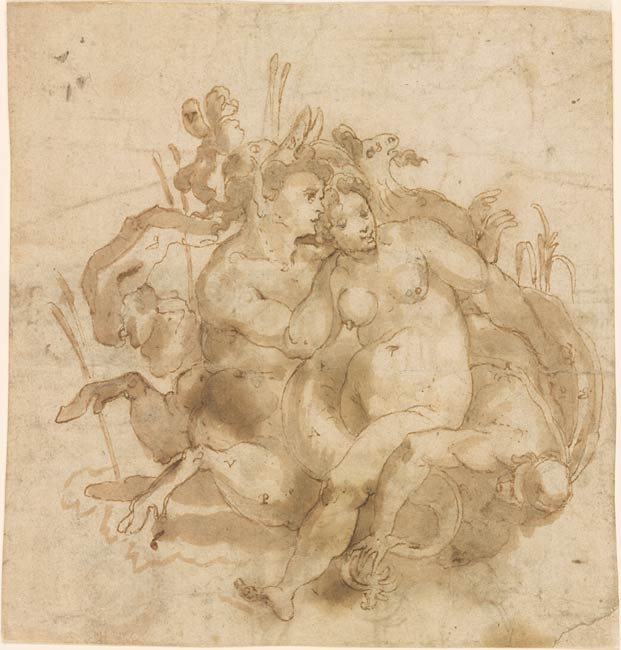

This drawing appears to be from the mid-sixteenth century by an artist working in Rome, possibly someone in the orbit of Perino del Vaga or Taddeo Zuccaro. Similar marine couples in fresco and stucco are found in the various rooms of Castel Sant’Angelo, Rome, decorated by Perino del Vaga and his workshop.1 The letters throughout the Morgan sheet likely functioned as color indications. It is therefore unlikely that the drawing was made in connection with stucco decorations, which were typically monochromatic. Drawings featuring similar subject matter made in connection with the work at Castel Sant’Angelo also survive, including one in the National Gallery of Art, Washington, attributed to Pellegrino Tibaldi, and one in the Ratjen Foundation collection, Vaduz, ascribed to the circle of Perino del Vaga.2 Marine couples are also present in the decorations in the Sala del Cigno at Caprarola, decorated by Federico Zuccaro’s workshop.3 A drawn design for a decorative frame attributed to an anonymous member of the Zuccaro studio shows at lower center a roundel depicting a triton embracing a sea-nymph, though in a pose that differs from the couple shown in the Morgan drawing.4 Compare also two drawings by Taddeo Zuccaro of marine deities in cartouches, both in private collections in the United States, and used for monochromatic frescoes painted in ca. 1567 in the Salone delle Guardie, Palazzo Farnese at Caprarola, after the artist’s death.5
The near circular shape of the recto composition suggests a roundel. The drawings on the verso seem to be from early Christian and antique Roman monuments.
Footnotes:
- See, for instance, the Sala della Biblioteca (Rome 1981-82, 1: 98-99, figs. 7, 9); the stucco and fresco decoration in the Sala Paolina (Rome 1981-82, 1: 168, 198, figs. 104, 149); and the frescoes in the Sala di Apollo (Rome 1981-82, 1: 236, figs. 203, 204).
- National Gallery of Art, Washington, inv. 1984.3.65. See Rome 1981-82, 2: 136, 151, figs. 83, 100.
- For the Sala del Cigno at Caprarola, see Acidini Luchinat, 1999, 2: fig. 45.
- Gere 1970, 133, no. 26.
- Acidini Luchinat 1999, 2: 23-24, figs. 42, 43.
Watermark: none.
Possible attribution includes Perino del Vaga (1501-1547); Taddeo Zuccaro (1529-1566).
Inscribed in pen and brown ink on parts of the composition, read from left to right and top to bottom, with the letters, "V, D, I, P, A, A, V, P [... and more]." Inscribed, perhaps by Hans Hesslein, on strip of cardboard, taken from old mount and now in the departmental file, "German or Suisse [sic] - 2nd half 16 century."
Perino, del Vaga, 1500 or 1501-1547, Possible attribution.
Zuccaro, Taddeo, 1529-1566, Possible attribution.
Hesslein, Hans G., 1903-1979, former owner.
Ryskamp, Charles, ed. Seventeenth Report to the Fellows of the Pierpont Morgan Library, 1972-1974. New York : Pierpont Morgan Library, 1976, p. 170.
